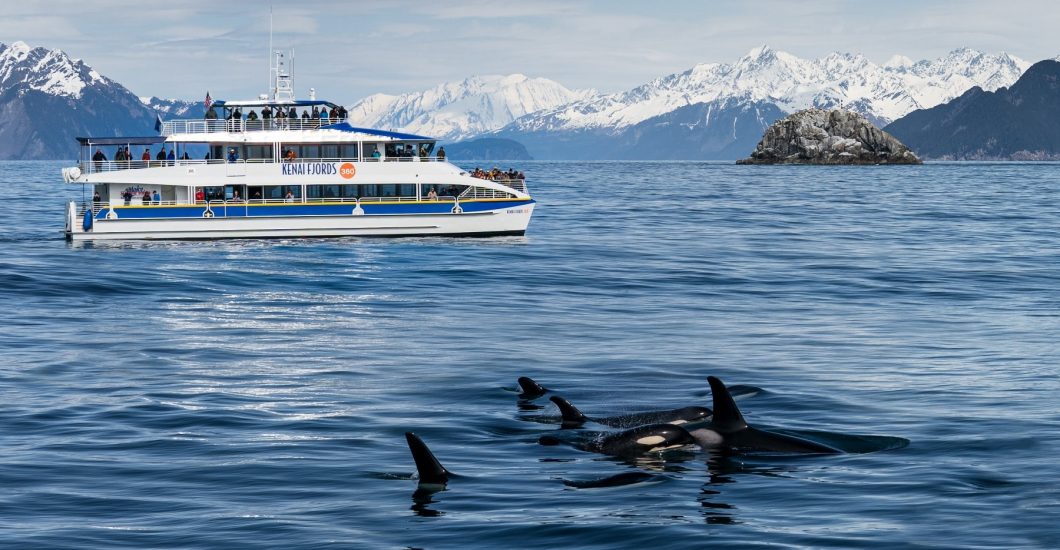
Our cruises into Kenai Fjords National Park offer some of the best whale watching opportunities in Alaska. Cruising among some of the world’s largest mammals and observing their behavior is an experience like no other.
Humpbacks and orcas are the most commonly seen whale species in Kenai Fjords National Park. Gray whales are seen only in the spring as they pass through the Gulf of Alaska on their annual migration. Fin whales and minke whales are also found in the area, though sightings of those species are rare. As a general rule of thumb, the more time you are on the water, the better your chances of spotting whales – especially in May, August, and September, which fall outside the peak whale watching season.
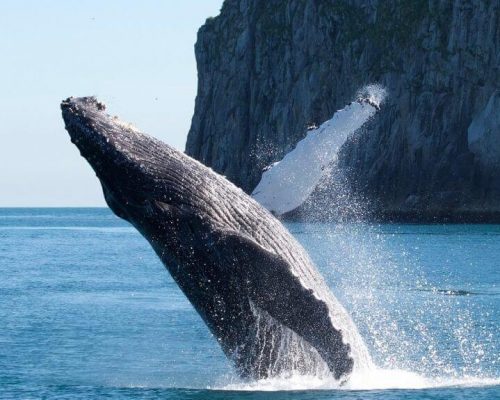
The giant humpback whale, well known for its spectacular breaching, is very common in Alaskan waters. Weighing up to 40 tons, humpbacks feed mainly on plankton and krill and can consume as much as one ton per day. They use fringed plates in their mouth called baleen to filter small food from the water. Although it’s possible to see humpbacks year-round in Alaska, most migrate to the warmer waters of Hawaii in the winter where they reproduce and give birth. This migration takes approximately 4 to 8 weeks and spans nearly 3,500 miles. During the spring, humpbacks migrate back to Alaska to spend the summers feeding in Alaska’s nutrient-rich waters.
BEST CRUISES FOR VIEWING:
6 Hour Kenai Fjords National Park Cruise
7.5 Hour Kenai Fjords National Park Cruise
8.5 Hour Northwestern Fjord Cruise
VIEWING TIME: April – October
BEST VIEWING TIME: Mid-May – Mid-August
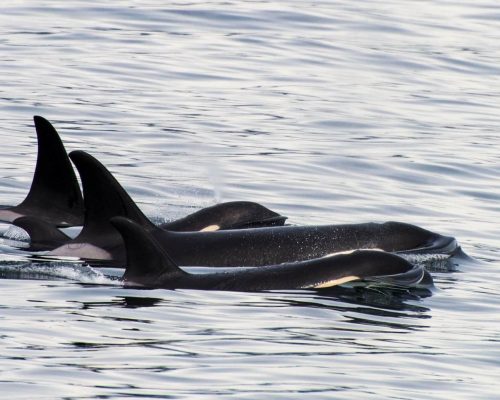
Often called killer whales, orcas are the largest member of the dolphin family and can swim up to 30mph. They are 15 – 30 feet long and can weigh up to 10 tons. Orcas generally travel in pods. Unlike humpbacks, orcas do not display any regular migration patterns. Instead, their movement is based on food availability, socializing with other pods, and ice coverage. There are three main classifications of orcas: resident, transient, and offshore. Resident orcas, which are most commonly seen on our tours, feed primarily on fish. Transient orcas come to the area to feed on marine mammals like seals and Steller sea lions and are less commonly seen. Offshore orcas feed mainly on sharks in the open ocean and are rarely seen in the area. Orcas are distinguished by the black and white markings and tall dorsal fins that make each orca unique.
BEST CRUISE FOR VIEWING:
Orca Quest Cruise
VIEWING TIME: Year-round
BEST VIEWING TIME: Mid-May – June
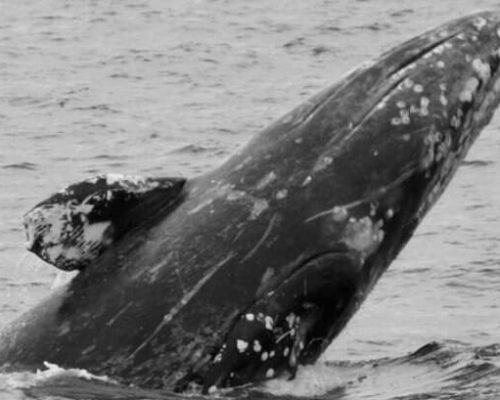
Every year, gray whales migrate over 10,000 miles round-trip between Baja and the Bering and Chukchi Seas – the longest migration route of any mammal. These whales begin migrating north in late February and arrive in Alaska in the spring, spending the summer feeding in shallow Arctic waters before migrating south in mid-October. They deliver their calves in the warm, protected lagoons off the coast of Baja in the winter. Newborn gray whales weigh approximately 1,500 pounds and adults can weigh between 16 and 45 tons and reach 36 – 50 feet in length. Gray whales are the only baleen whales that are primarily bottom feeders. They lay on their sides on the ocean floor and suck up sediment, filtering out food with their baleen.
BEST CRUISE FOR VIEWING:
Spring Wildlife Cruise
VIEWING TIME: March – May
BEST VIEWING TIME: Mid-April – May
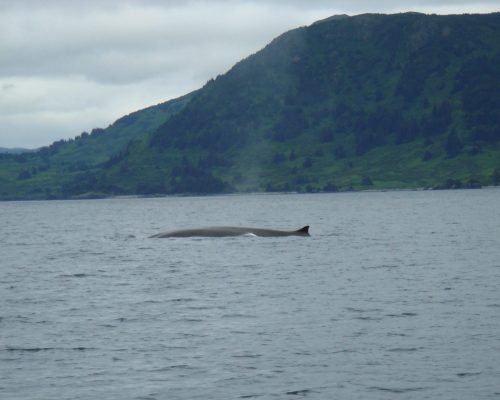
Fin whales, also known as finback whales, are the second largest mammals and are among the fastest of all whales, capable of speeds of up to 23 mph. They can be found in all oceans, migrating from the warm waters during the winter to the colder waters during the summer. Like all baleen whales, fin whales feed on small fish and shrimp-like creatures called krill. Fin whales prefer the open ocean and generally travel alone, although pods of 5-6 have been seen together.
BEST CRUISES FOR VIEWING:
6 Hour Kenai Fjords National Park Cruise
7.5 Hour Kenai Fjords National Park Cruise
8.5 Hour Northwestern Fjord Cruise
VIEWING TIME: May – September
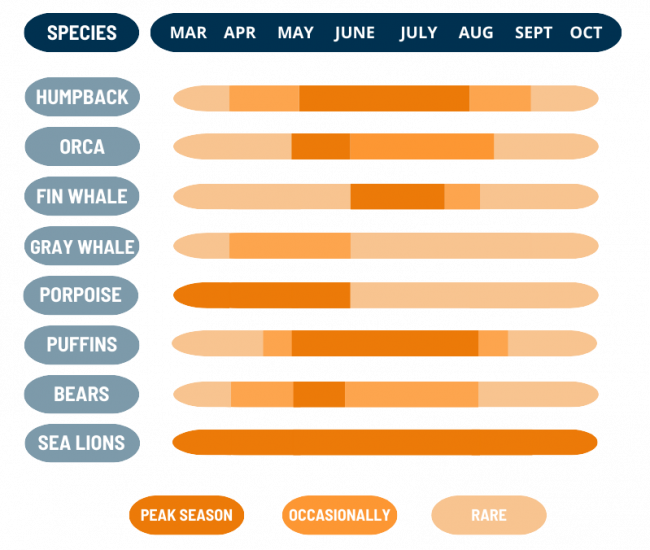
Like all mammals, whales breathe air into their lungs, making it easy to spot them on the surface of the water as they come up for air. This behavior is called spouting, and is the most commonly-seen whale behavior on our cruises.
In addition to spouting, you may see behaviors such as breaching or lunging. Breaching is when a whale leaps more than half-way out of the water, and lunging is when a whale leaps less than half way out of the water. Some experts believe that breaching and lunging are part of the feeding habits of whales, while others believe that this behavior is simple playfulness.
You may also witness spyhopping, when a whale sticks its head out of the water to examine its surroundings. Finally, you may see tail lobbing or tail slapping. Tail lobbing is when a whale lifts its tail fluke out of the water and slaps it down on the water’s surface, often repeating the movement several times. Tail slapping is when a whale uses its fins or flippers to slap the surface of the water.
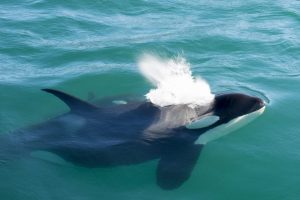
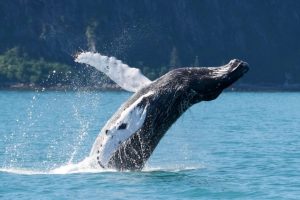
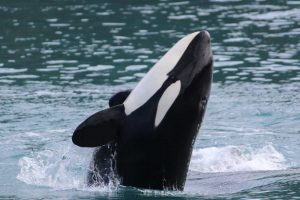
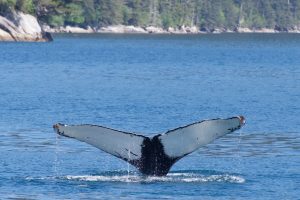
Major Marine Tours is committed to protecting the health and safety of the whales that inhabit our area. We are a proud member of Whale SENSE, a program sponsored by NOAA Fisheries and Whale & Dolphin Conservation that recognizes companies that are committed to responsible whale watching practices. We abide by all NOAA marine mammal viewing guidelines and promote ocean stewardship through our partnerships with the National Park Service and Alaska SeaLife Center.
While we can’t guarantee whales sightings, this guide is here to help you plan the best time for your Alaska whale watching cruise. You can call our reservations line at (907) 224-8030 to find out how our whale watching season is going and what whales have recently been seen.
Signup for our newsletter to get the most recent Major Marine updates.